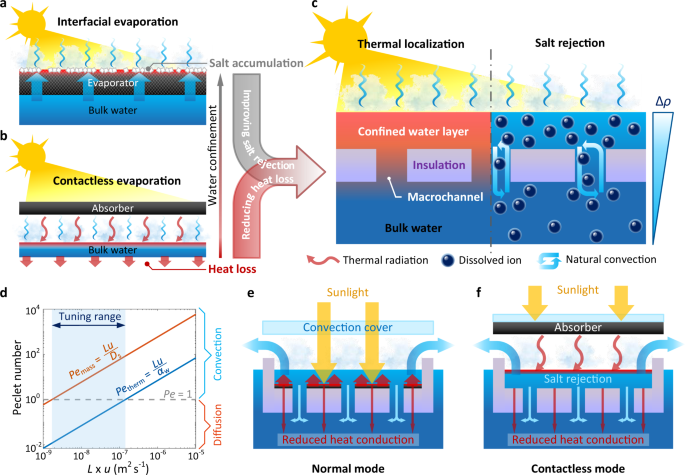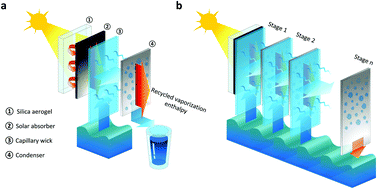2023-09-27 マサチューセッツ工科大学(MIT)
◆このシステムは高い水産出率と塩除去率を持ち、小さな家族の日常の飲料水供給に適しています。将来的には、米国の水道水よりも安価に飲料水を提供できる可能性があります。
<関連情報>
- https://news.mit.edu/2023/desalination-system-could-produce-freshwater-cheaper-0927
- https://www.cell.com/joule/fulltext/S2542-4351(23)00360-4
- https://www.nature.com/articles/s41467-022-28457-8
- https://pubs.rsc.org/en/content/articlelanding/2020/ee/c9ee04122b#!divAbstract
熱水対流を利用した極端な耐塩性多段式太陽熱蒸留法 Extreme salt-resisting multistage solar distillation with thermohaline convection
Jintong Gao,Lenan Zhang,Jinfang You,Zhanyu Ye,Yang Zhong,Ruzhu Wang,Evelyn N. Wang,Zhenyuan Xu
Joule Published:September 27, 2023
DOI:https://doi.org/10.1016/j.joule.2023.08.012

Highlights
•Thermohaline convection is initiated in confined-saline-layer evaporation
•Record-high efficiencies are achieved in the salinity range of 0–20 wt %
•180-h continuous distillation of 20 wt % concentrated seawater is realized
Summary
Recent advances in multistage solar distillation are promising for the sustainable supply of freshwater. However, significant performance degradation due to salt accumulation has posed a challenge for both long-term reliability of solar desalination and efficient treatment of hypersaline discharge. Here, inspired by a natural phenomenon, thermohaline convection, we demonstrate a solar-powered multistage membrane distillation with extreme salt-resisting performance. Using a confined saline layer as an evaporator, we initiate strong thermohaline convection to mitigate salt accumulation and enhance heat transfer. With a ten-stage device, we achieve record-high solar-to-water efficiencies of 322%–121% in the salinity range of 0–20 wt % under one-sun illumination. More importantly, we demonstrate an extreme resistance to salt accumulation with 180-h continuous desalination of 20 wt % concentrated seawater. With high freshwater production and extreme salt endurance, our device significantly reduces the water production cost, paving a pathway toward the practical adoption of passive solar desalination for sustainable water economy.
芯のない閉じ込められた水層を介した、高効率で塩分を拒絶する太陽熱蒸発 Highly efficient and salt rejecting solar evaporation via a wick-free confined water layer
Lenan Zhang,Xiangyu Li,Yang Zhong,Arny Leroy,Zhenyuan Xu,Lin Zhao & Evelyn N. Wang
Nature Communications Published:14 February 2022
DOI:https://doi.org/10.1038/s41467-022-28457-8

Abstract
Recent advances in thermally localized solar evaporation hold significant promise for vapor generation, seawater desalination, wastewater treatment, and medical sterilization. However, salt accumulation is one of the key bottlenecks for reliable adoption. Here, we demonstrate highly efficient (>80% solar-to-vapor conversion efficiency) and salt rejecting (20 weight % salinity) solar evaporation by engineering the fluidic flow in a wick-free confined water layer. With mechanistic modeling and experimental characterization of salt transport, we show that natural convection can be triggered in the confined water. More notably, there exists a regime enabling simultaneous thermal localization and salt rejection, i.e., natural convection significantly accelerates salt rejection while inducing negligible additional heat loss. Furthermore, we show the broad applicability by integrating this confined water layer with a recently developed contactless solar evaporator and report an improved efficiency. This work elucidates the fundamentals of salt transport and offers a low-cost strategy for high-performance solar evaporation.
熱局在型多段式ソーラースチルによる超高効率海水淡水化 Ultrahigh-efficiency desalination via a thermally-localized multistage solar still
Zhenyuan Xu,Lenan Zhang,Lin Zhao,Bangjun Li,Bikram Bhatia,Chenxi Wang,Kyle L. Wilke,Youngsup Song,Omar Labban,John H. Lienhard,Ruzhu Wang and Evelyn N. Wang
Energy and Environmental Science Published:15 Jan 2020
DOI:https://doi.org/10.1039/C9EE04122B
Abstract
Passive vapor generation systems with interfacial solar heat localization enable high-efficiency low-cost desalination. In particular, recent progress combining interfacial solar heating and vaporization enthalpy recycling through a capillary-fed multistage architecture, known as the thermally-localized multistage solar still (TMSS), significantly improves the performance of passive solar desalination. Yet, state-of-the-art experimental demonstrations of solar-to-vapor conversion efficiency are still limited since the dominant factors and the general design principle for TMSS were not well-understood. In this work, we show optimizing the overall heat and mass transport in a multistage configuration plays a key role for further improving the performance. This understanding also increases the flexibility of material choices for the TMSS design. Using a low-cost and free-of-salt accumulation TMSS architecture, we experimentally demonstrated a record-high solar-to-vapor conversion efficiency of 385% with a production rate of 5.78 L m−2 h−1 under one-sun illumination, where more than 75% of the total production was collected through condensation. This work not only significantly improves the performance of existing passive solar desalination technologies for portable and affordable drinking water, but also provides a comprehensive physical understanding and optimization principle for TMSS systems.




